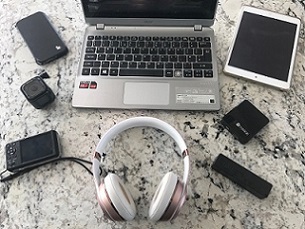 All these electronic items powered by lithium batteries are taken on board aircraft by passengers
All these electronic items powered by lithium batteries are taken on board aircraft by passengers
 The last place you want a lithium battery fire is in the confined space of an aircraft cabin
The last place you want a lithium battery fire is in the confined space of an aircraft cabin
 A pilot with an AvSax thermal fire mitigation bag
A pilot with an AvSax thermal fire mitigation bag
Four cabin crew were taken to hospital following a fire on board a passenger plane caused by lithium-ion batteries.
The emergency happened just minutes after the United Airlines flight had taken off from San Diego International Airport in California when a passenger’s battery pack caught fire at 7.30am on Tuesday, February 7.
The crew tackled the fire and then put the battery pack into a lithium battery fire mitigation bag as the plane turned round and made an emergency landing back at San Diego just minutes later.
The four crew were taken to hospital suffering from the effects of breathing in smoke. Three other people on board were slightly hurt but did not go to hospital.
The plane had been due to fly across the USA to Newark Liberty International Airport in New Jersey and had been in the air for seconds when the fire broke out.
In a statement United Airlines said the crew “acted quickly to contain the device,” adding “we thank our crew for their quick actions in prioritising the safety of everyone on board the aircraft.”
The incident will now be investigated by the Federal Aviation Administration (FAA) and the National Transportation Safety Board in the USA.
This means there have been 407 incidents involving lithium batteries on aircraft since 2006 involving American aircraft or in American airspace as the figures have been collated by the FAA in the US.
Of these, 178 were batteries or battery packs, 78 involved vapes or e-cigarettes, 51 were mobile phones, 51 were other electrical devices, 47 involved laptops and two were medical devices powered by lithium batteries.
Passengers take hundreds of electronic devices on every flight and the risk is now deemed high enough for cabin crew to stress during the safety briefing before each flight that passengers must let them know if their device starts to overheat, emits smoke or is lost down the seat. If the seat is moved, the device could be crushed, sending the battery into thermal runaway. Many airlines now carry lithium battery fire mitigation bags such as AvSax so they are ready for such an emergency.
Lithium batteries are classed as dangerous goods and must be carried in the passenger cabin so if they did overheat or catch fire the crew can quickly tackle the problem.
Lithium batteries burn at such an intense heat if they were in luggage in the hold a fire could quickly spread and the automatic fire suppression systems could struggle to cope.
When lithium batteries overheat or catch fire they go into what’s known as thermal runaway. This happens when one cell in a battery overheats it can produce enough heat – up to 900°C (1652°F) – to cause adjacent cells to overheat. This can cause a lithium battery fire to flare repeatedly and they are very difficult to put out which is why it must go into lithium battery thermal containment bag as quickly as possible.
Many airlines now carry them and the world’s best-selling lithium battery fire mitigation bag is the AvSax which has been deployed in action 33 times on board aircraft since 2017.
The reason AvSax are so effective and are the main choice for airlines is that these thermal containment bags are designed to continually cool the overheating battery and part of the emergency procedure is to pour water into bag which then expands around the overheating device and cools it.
This use of liquid is recommended by the Civil Aviation Authority (CAA) in the UK and many other fire containment bags don’t work this way. Read more by clicking here.
In its guidance the CAA states: “Since the development of the International Civil Aviation Organization (ICAO) guidance on dealing with an in-flight battery fire, new products designed for use in response to lithium battery thermal runaway events have become available.
“Products which provide both a cooling and containment capability are typically more aligned to the existing ICAO guidance as when used they are filled with water or other non-flammable liquid to act as a cooling agent.
“After knocking down flames it could conceivably take just a couple of seconds for a personal electronic device to be placed inside a containment bag, allowing it to be moved to a place of safety. Passengers could then return to their seats, mitigating potential unrelated safety hazards such as injury in the case of severe turbulence. Equally, the effect on flight crew in carrying out their duties following an event on the flight deck would be minimised.”
AvSax were devised by Environmental Defence Systems Ltd based in Huddersfield, West Yorkshire and the company won the Queen’s Award for Enterprise for their innovation in the UK – the top accolade any business can get.